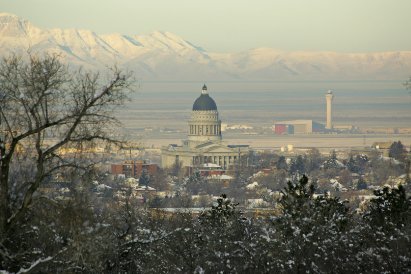 by Elizabeth Joy, MD, MPH, Michelle Hofmann, MD, MPH, & Steven Bergstrom
by Elizabeth Joy, MD, MPH, Michelle Hofmann, MD, MPH, & Steven Bergstrom
It comes as no surprise to anyone living along Utah’s Wasatch Front that our air quality is compromised for days to weeks come wintertime. Our murky air is referred to as an “inversion” as it is the reverse of a normal air pattern (i.e., cooler air above, warmer air below). During inversions, the Wasatch Front valleys and their surrounding mountains act like bowls, trapping a dense layer of cold air under a layer of warm air. The warm layer acts much like a lid, and any pollution produced during an inversion becomes trapped in the cold air near the valley floor (Figure 1). This warm inversion air layer is usually displaced when a strong storm system blows in, releasing lower polluted air, and restoring air quality to healthier levels.
Children with Acute Respiratory Problems Face a Higher Risk During an Inversion
Poor air quality is unhealthy for everyone, but some groups are more susceptible than others. Children, especially those with asthma, are considered at high risk because they spend more time playing outdoors, their bodies are still developing, and they breathe more rapidly than adults, inhaling more air per pound of body weight. The elderly and those with acute or chronic respiratory problems, or vascular diseases such as heart disease or stroke, are also at high risk. Given that nearly one third of Utah’s population is younger than 18 or older than 65, in addition to the more than 200,000 Utahns with asthma, and 500,000 with heart disease, addressing air quality is indeed a public health imperative.
The primary contributor to our poor air quality and its impact on health during an inversion is fine particulate matter (PM) pollution. Often referred to as PM2.5, the 2.5 refers to the size of the particle (2.5 micrometers per cubic meter). Figure 2 provides some perspective on the size of these particles-which is 30 times smaller than a human hair!
Monitor Air Quality and Protect Your Family’s Health
A growing body of evidence suggests that even on some of Utah’s best air quality days, there are pollution sources that may be impacting health. In particular, living, working, and attending school within close proximity to major roadways results in exposure to automotive emissions that are a major source of PM2.5 and other harmful air pollutants. Considering how you can prevent or reduce exposures to vehicle exhaust is a good step everyone can take to protect themselves and their children from some of the harmful effects of air pollution. Avoid idling your vehicle, exercise outdoors away from major roadways, and for schools located near highways, schedule outdoor activities outside of peak rush hour times.
Other ways to protect ourselves and our loved ones include “reading the air.” Much like checking the temperature to know how to dress for the day, look at the current air quality conditions to know if you and your family need to use extra caution with outdoor activities that increase pollution exposures. Useful tools for monitoring air quality can be found on www.airnow.gov or www.airquality.utah.gov, or UtahAir, an app that can be downloaded onto your smart phone for real time, local air quality information. These tools also provide exposure recommendations for people with and without sensitive conditions that may be exacerbated by poor air quality. First and foremost, always listen to your body, and consider if air quality may be influencing you or your child’s health, by monitoring for symptoms like increased cough, chest tightness, wheezing, or difficulty breathing after exposures to air pollution.
Personal Responsibility in Air Quality Improvement
In addition to protecting our health, we all have a responsibility to improve air quality in Utah. Utah’s Clean Air Action Team (CAAT) published a number of recommendations aimed at improving our air quality. Some of these recommendations are aimed at policy makers such as access to lower sulfur gasoline, and investing resources to expand public transportation.
However, there are several recommendations that are actionable at an individual or household level. These include reducing both wood burning and total miles driven per person during inversion periods, and installation of ultra-low nitrogen oxide water heaters. According to the CAAT report, the emissions from heating 1 home with wood burning as the sole heating source is equivalent to emissions from 200 homes heated with natural gas in terms of fine particulate matter (PM2.5). Be a part of the solution, by doing all that you can to reduce your own contribution to Utah’s poor air quality.
About the Author
Share This Article
Search Our Blog
Our Instagram
 primarychildrens
220
Likes
primarychildrens
220
Likes
 primarychildrens
247
Likes
2
Comments
primarychildrens
247
Likes
2
Comments
 primarychildrens
401
Likes
5
Comments
primarychildrens
401
Likes
5
Comments
 primarychildrens
326
Likes
2
Comments
primarychildrens
326
Likes
2
Comments
 primarychildrens
304
Likes
8
Comments
primarychildrens
304
Likes
8
Comments
 primarychildrens
149
Likes
primarychildrens
149
Likes
 primarychildrens
143
Likes
1
Comments
primarychildrens
143
Likes
1
Comments
 primarychildrens
156
Likes
2
Comments
primarychildrens
156
Likes
2
Comments

Recent Posts
- Pediatric Liver Transplant Program Celebrates 200 Lives Saved and 20 Years December 30, 2015
- Is it the Cold or the Flu? December 18, 2015
- Play it Safe Outside this Winter December 15, 2015
- 10 Tips for Choosing Safe Toys this Christmas + [Infographic] December 10, 2015
- The Air We Breathe: Protecting Your Kids During an Inversion December 3, 2015
Our Most Popular Posts
 Pediatric Liver Transplant Program Celebrates 200 Lives Saved and 20 Years 331 views
Pediatric Liver Transplant Program Celebrates 200 Lives Saved and 20 Years 331 views  On Childhood Cancer: Perspectives of a Pediatric Oncologist 17 views
On Childhood Cancer: Perspectives of a Pediatric Oncologist 17 views  Celebrating the First X-Ray and Radiology’s Contributions to Children’s Health Care 17 views
Celebrating the First X-Ray and Radiology’s Contributions to Children’s Health Care 17 views  Why Kids Shouldn’t Wear Bulky Coats in Car Seats 16 views
Why Kids Shouldn’t Wear Bulky Coats in Car Seats 16 views  Six Ways Child Life Specialists Improve Your Child’s Hospital Stay 16 views
Six Ways Child Life Specialists Improve Your Child’s Hospital Stay 16 views  “It Takes an Army of Heroes . . . ” A Parent’s Perspective on Tragedy 13 views
“It Takes an Army of Heroes . . . ” A Parent’s Perspective on Tragedy 13 views  Orthopedic Care by the Numbers 12 views
Orthopedic Care by the Numbers 12 views  Groundbreaking Research Studying Cancer in Elephants Spurs New Funding for Childhood Cancer 12 views
Groundbreaking Research Studying Cancer in Elephants Spurs New Funding for Childhood Cancer 12 views - Bone Fractures: From Break to Cast Removal 12 views
 Think BIG on #GivingTuesday and Support Childhood Cancer Research 12 views
Think BIG on #GivingTuesday and Support Childhood Cancer Research 12 views
Archives
- December 2015 (5)
- November 2015 (8)
- October 2015 (8)
- September 2015 (2)
- August 2015 (1)
- July 2015 (3)
- June 2015 (2)
- May 2015 (2)
- March 2015 (3)
- February 2015 (2)
- January 2015 (2)
- November 2014 (1)
- October 2014 (1)
- September 2014 (3)
- August 2014 (2)
- July 2014 (4)
- June 2014 (2)
- May 2014 (4)
- April 2014 (6)
- March 2014 (4)
- February 2014 (1)
- September 2013 (1)
- February 2013 (1)
- June 2012 (1)















Add comment